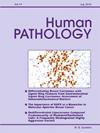子宫内膜间质肉瘤累及肠道和肝脏:扩大累及胃肠道间充质肿瘤的鉴别诊断
IF 2.7
2区 医学
Q2 PATHOLOGY
引用次数: 0
摘要
子宫内膜间质肉瘤(ESS)是一种以浸润性生长和淋巴血管侵袭而闻名的间充质肿瘤。大多数病例发生在子宫内膜,但也有一些发生在腹腔,没有原发性子宫病变,可能是由子宫内膜异位症引起的。累及胃肠道和肝脏的ESS是罕见的。我们回顾了2010年至2023年间13名女性的15个例子。平均年龄51岁(16 ~ 81岁);超过一半的患者(7/ 13,54 %)有子宫ESS病史。12个肿瘤累及肠道,3个累及肝脏;直肠乙状结肠是最受影响的部位。肿瘤平均4.6厘米(范围0.3-10厘米),累及所有肠层,其中两层表现为跨壁累及。主要观察到低级别特征,包括纤维或黏液样基质中均匀的圆形到梭形细胞,渗透性生长,透明斑块和螺旋小动脉。子宫内膜异位症4例(27%)。免疫组化分析显示ER(93%)、PR(92%)、CD10(91%)和局灶细胞周期蛋白D1(80%)呈阳性。少数病例显示平滑肌标记物、CD117、DOG1和角蛋白染色。有3例提出了高级别特征,但不能诊断。3例患者的随访数据显示,1例患者在16个月时死亡,1例患者在94个月时无病,另1例患者在16个月时存活。累及胃肠道的ESS很少见,可能缺乏子宫原发灶,并且由于角蛋白、平滑肌和CD117/DOG1的表达,可以模仿其他肿瘤。识别ess相关特征,如渗透性、透明斑块和螺旋小动脉,是避免误诊的关键。本文章由计算机程序翻译,如有差异,请以英文原文为准。
Intestinal and liver involvement by endometrial stromal sarcoma: Expanding the differential diagnosis of mesenchymal tumors involving the GI tract
Endometrial stromal sarcoma (ESS) is a mesenchymal tumor known for infiltrative growth and lymphovascular invasion. Most examples arise in the endometrium, but some occur in the abdominal cavity without a primary uterine lesion, likely originating from endometriosis. ESS involving the gastrointestinal (GI) tract and liver is rare. We reviewed 15 examples from 13 women between 2010 and 2023. The mean age was 51 (range 16–81); just over half of the patients (7/13, 54 %) had a history of uterine ESS. Twelve tumors involved the intestines and three the liver; rectosigmoid colon was the most affected site. Tumors averaged 4.6 cm (range 0.3–10 cm) and involved all bowel layers with two showing transmural involvement. Predominantly low-grade features were observed, including uniform round to spindle cells in fibrous or myxoid stroma, permeative growth, hyaline plaques, and spiral arterioles. Endometriosis was seen in 4 (27 %) cases. Immunohistochemical analysis revealed positivity for ER (93 %), PR (92 %), CD10 (91 %), and focal cyclin D1 (80 %). A minority of cases showed staining with smooth muscle markers, CD117, DOG1, and keratins. High-grade features were suggested but not diagnostic in three cases. Follow-up data for three patients showed one death at 16 months, one patient disease-free at 94 months, and another alive at 16 months. ESS involving the GI tract is rare, may lack a uterine primary, and can mimic other neoplasms due to keratin, smooth muscle, and CD117/DOG1 expression. Recognizing ESS-associated features—such as a permeative pattern, hyaline plaques, and spiral arterioles—is key to avoiding misdiagnosis.
求助全文
通过发布文献求助,成功后即可免费获取论文全文。
去求助
来源期刊

Human pathology
医学-病理学
CiteScore
5.30
自引率
6.10%
发文量
206
审稿时长
21 days
期刊介绍:
Human Pathology is designed to bring information of clinicopathologic significance to human disease to the laboratory and clinical physician. It presents information drawn from morphologic and clinical laboratory studies with direct relevance to the understanding of human diseases. Papers published concern morphologic and clinicopathologic observations, reviews of diseases, analyses of problems in pathology, significant collections of case material and advances in concepts or techniques of value in the analysis and diagnosis of disease. Theoretical and experimental pathology and molecular biology pertinent to human disease are included. This critical journal is well illustrated with exceptional reproductions of photomicrographs and microscopic anatomy.
 求助内容:
求助内容: 应助结果提醒方式:
应助结果提醒方式:


